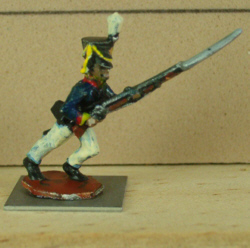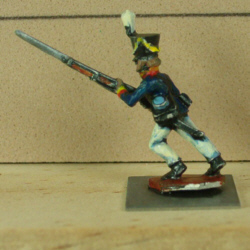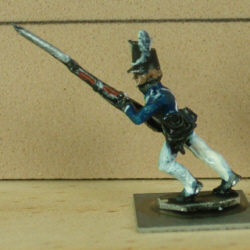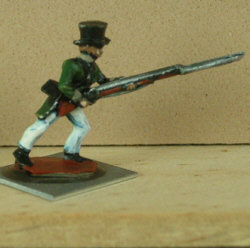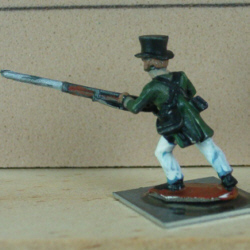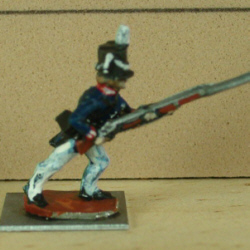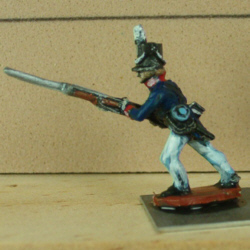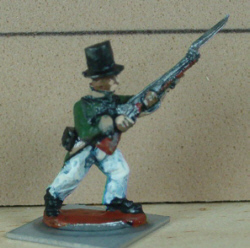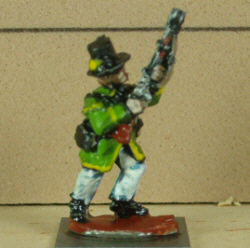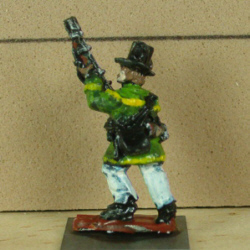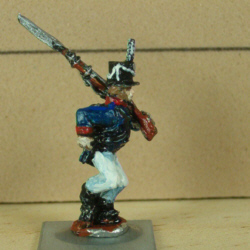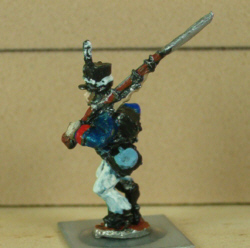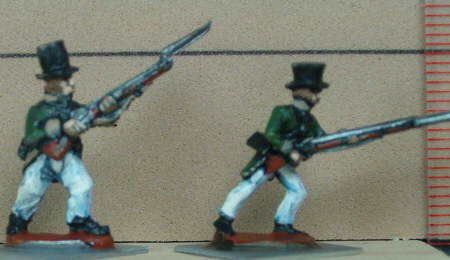|
|
||||||||||||||||||
 |
||||||||||||||||||
 |
|
Note: The following review was written by Peter Murray, another TMP regular. He painted the figures you see below. Photos are by the editor. We are working to get improved photos... MINIFIGS First figure is Minifigs pack code 15070007: US Infantry Advancing in Shako/Coatee.
My initial impression on seeing the bare metal was: Oooh, he's smooth. But that's good! The casting is very clean, and there's a good amount of detail on the figure. Straps and cuffs are inscribed instead of raised, but that helps keep the profile flat. Kit looks good, and the hat cord and plume are very nice looking. The musket is simple but clear, and the bayonet is a nice shape, even if it is a bit large. It's actually worth talking about the shako for a minute. It's a very nice shape, but an uncommon one in the regulars of the period. But it is perfect for those regiments of artillery who fought as infantry! So I've painted this fellow as one of these unfortunate artilleryman, with a yellow hat cord and red cuffs edged yellow. The pose is a good advancing pose. He's not leaping headlong into the enemy lines, but there's a good impression of energy. Anatomy is very good. While slender, the proportions are quite good, and the face may be a bit obscured, but it's also under a shako and you wouldn't see much anyway. Next figure is Minifigs 15070004: US Infantry Advancing in Leather Shako
For 1814, the well-dressed American infantryman is wearing a uniform of simpler cut (oooh!) with a new hat, inspired by the latest European "false front" fashion (aaah!). We've replaced last season's dull black straps with white, too! The accouterments like the musket and kit are the same as before: simple and clear, with a big ole bayonet. Again, this is a figure where the fine details (including epaulettes here) are inscribed rather than sculpted. This keeps the figure neat and trim, though you'll have to brush lines rather closely. The pose is advancing, and again, not excessively balletic, but clearly energetic. This would be a good figure to use for the later battles on the Canada front (someone lucky enough to get a new outfit!), or a US regular down in the Chesapeake area or points closer to the supply depots. He might even make a good appearance at New Orleans, provided you can fit him in between piles of pirates, irregulars, and Andy Jackson. If you thought the leather shako was the new black, wait till you see #15070012: US Militiaman Advancing in Top Hat!
Painted here to resemble the Michigan United Volunteers, there's no reason at all you couldn't use him for one or more of the better-equipped militia or volunteer units, particularly those from the richer states. Again, energetic pose, nice kit, and inscribed Our last Minifigs representative is the most versatile, 15070001: US Infantryman in Felt Shako.
This is the uniform pattern and hat that predominated throughout the war. By judiciously switching colors, you can create most regular regiments as they would have appeared in their varied blue, gray, or brown jackets (or pants). This is a good figure for filling out ranks. Like his peers, he has an energetic pose and good kit. The casting is clean, and there's enough room on the cuffs and collars that you can attempt to paint white lace (like I tried). In sum, the Minifigs are all proportional and well-cast, with good and subtle detailing that rewards a careful hand, but does not excessively punish the beginning painter. They're a good cost per pack, and each pack includes command figures (which I hope to include soon.) OLD GLORY Old Glory was kind enough to send a bag of nearly thirty assorted figures to review, and so what I've done is pick three that will, I think, have the widest application to gamers (at least to start--I hope later I can review some of the other figures for you.) Let's start with this stylish gentleman in the top hat. I've painted him for the Michigan United Volunteers. The pose is good--it's immediately recognizable as being an Old Glory advancing pose, but it's not as extreme as some OG poses I've seen. Detail is good, with the straps for the equipment and the cuffs sculpted separately. These help painting somewhat, and will also pick up a drybrush well. The musket looks like a musket. Proportions are decent, and he's neither gnomish nor giraffesque.
Our next figure seems to be a cross between a militiaman and a regular infantryman, which is appropriate because that's what he is! He's a regular from one of the rifle regiments, and his uniform of hunting frock and regular shako is captured well. The fringe on the coat will pick up a drybrush well. I was a bit confused as to what some of the things in his belt might be, since I had limited uniform information, particularly what looks like a powder flask up front. Note no bayonet on the rifle! This is the way it is supposed to be The detailing on the rifle looks close to a Harper's Ferry Armory model, too. The nice part about the rifle regiments in their green frock is that almost any color green will work--the dyes used were not colorfast and legendarily bad about losing their color. The pose is not quite as nice as the gentleman with the top hat, but there's nothing physically impossible about it, either. Again, proportions are decent, though this figure is a bit stouter than any of the Minifigs.
With any decent-sized US, you should throw in a regiment of riflemen. It's one of the unique features of the American army, and it'll make your opponent a bit reluctant to send General Whomever to the front lines to rally the troops. The last figure is an American regular in the felt shako. This is a good general-purpose-regular figure. The pose is energetic, with the musket shouldered on the advance, yet there's nothing forced about the way it looks. As with the other figure, cuffs and straps are separate sculpting, the musket is well represented, and the fall of the shako cord across the plate looks exactly like the ones in the Osprey illustration.
If there's one drawback to this figure, it's the narrow base. The entire figure can bend very easily at the ankles, making this one a figure you should avoid dropping or gluing too permanently to your painting surface. Overall, the Old Glory figures are chunkier than the Minifigs, but not gnomish. Detail is overstated for ease of painting, and the poses are recognizable OG without looking like they're walking through a hurricane while shooting squirrels.
|
|
[Home] [15mm World] [Reviews Home] [How To] [Beginners Guide] [Gamer's World] [Spanner & The Yank] [Points of View] [The Annex] [Links] [Say Howdy] [Corporate Schill] [Rules Directory] |
 |
